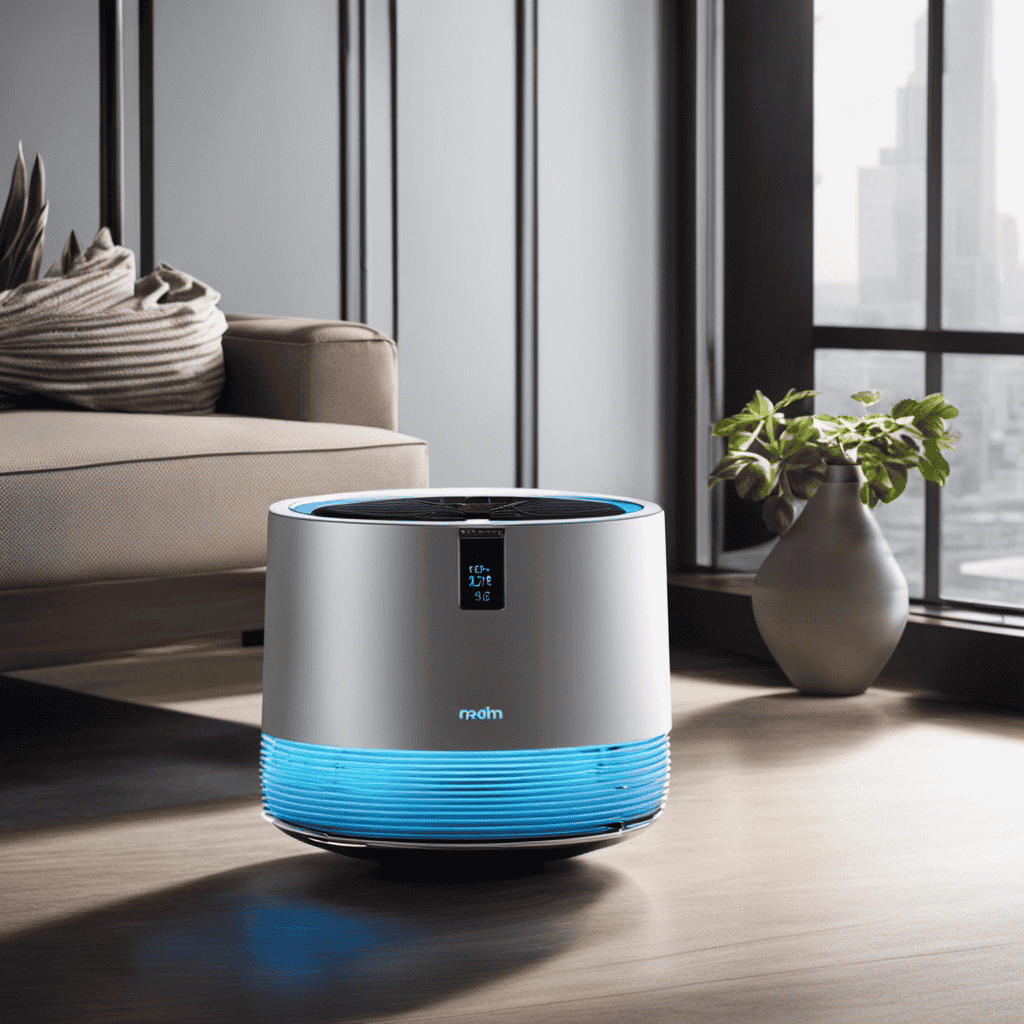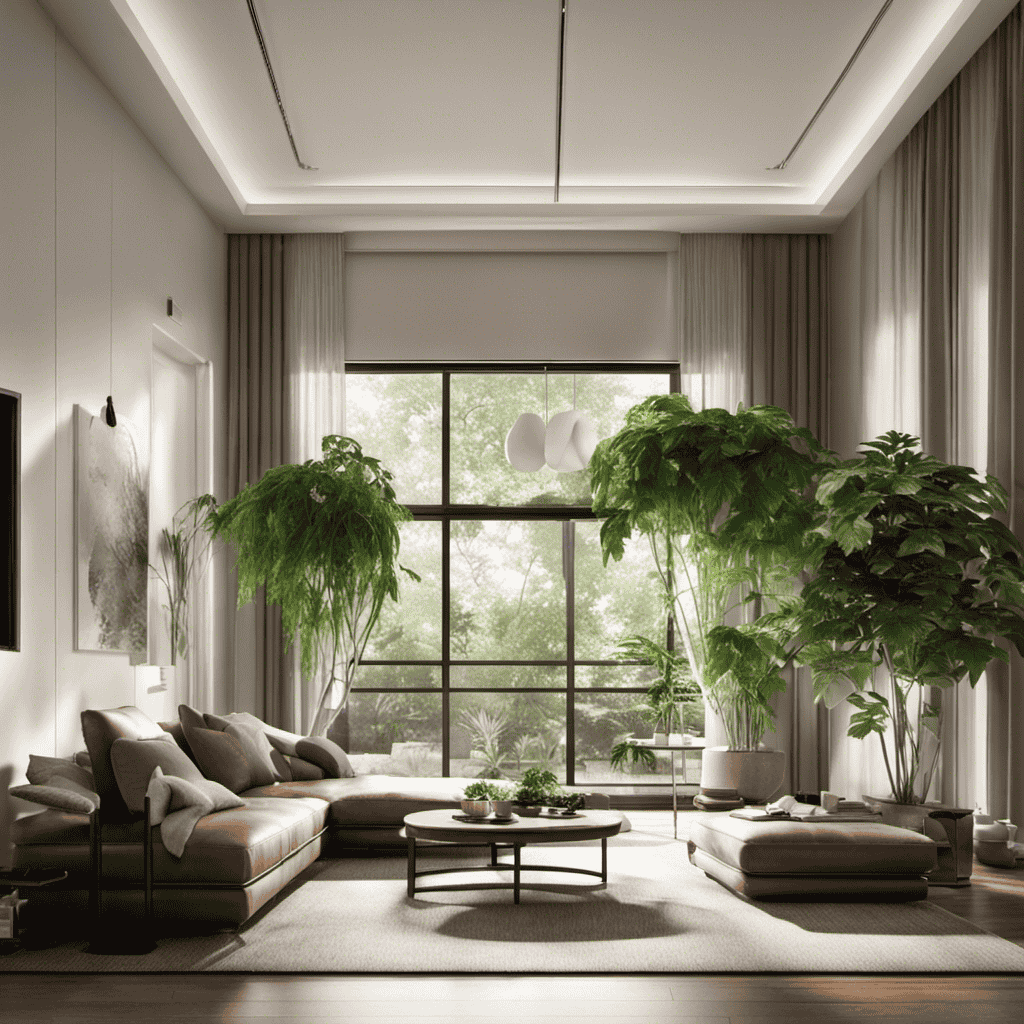Hello there!
So you’ve decided to invest in an air purifier, but now comes the important question: where should you actually place it? Well, lucky for you, I’ve got all the answers.
In this article, we’ll delve into the various ideal placements for your air purifier in different areas of your home, from the bedroom to the basement. Whether you’re looking for allergy relief, tackling high traffic areas, or even creating a smoker’s room oasis, I’ve got you covered.
So let’s dive in and find the perfect spot for your air purifier!
Key Takeaways
- Consider the size of the bedroom when choosing an air purifier and its capacity.
- Look for an air purifier with a HEPA filter for effective removal of fine particles.
- Choose a location with optimal air circulation and away from obstructions for optimal performance.
- Take into account the overall room decor and aesthetics when deciding on the placement of the air purifier.
Bedroom Placement
You should place an air purifier in your bedroom to improve the air quality while you sleep. The size of your bedroom will determine the type and capacity of air purifier you need. For smaller bedrooms, a compact air purifier with a coverage area of around 200 square feet should suffice. However, if you have a larger bedroom, you may require an air purifier with a higher coverage area.
Additionally, consider the features of the air purifier. Look for a model with a HEPA filter to remove fine particles like dust, pollen, and pet dander. Some air purifiers also come with activated carbon filters to eliminate odors.
With the right air purifier in your bedroom, you can enjoy cleaner and fresher air while you sleep.
Speaking of air purifiers, let’s now move on to discussing their placement in the living room.
Living Room Placement
When considering where to put an air purifier in a living room, it’s important to choose a location that allows for optimal air circulation. The placement of the air purifier can greatly affect its efficiency in improving the air quality in the room.
To ensure proper air circulation, it is best to place the air purifier in an open area, away from obstructions such as furniture or curtains. This will allow the purifier to pull in air from all directions and effectively clean it.
Additionally, consider the overall living room decor when choosing a spot for the air purifier. Look for a location that blends seamlessly with the room’s aesthetics and does not disrupt the flow of the space.
Kitchen Placement
When it comes to placing an air purifier in the kitchen, there are a few key considerations to keep in mind.
First and foremost, it should be positioned near cooking appliances to effectively capture and filter out any cooking odors or airborne particles.
However, it is important to place it away from food prep areas to avoid any potential contamination.
Lastly, easy access for cleaning is essential to ensure that the air purifier can be properly maintained and its filters can be replaced regularly for optimal performance.
Near Cooking Appliances
Avoid placing the air purifier near cooking appliances as it may get clogged with grease and other particles. Grease is a common byproduct of cooking, especially when using stovetops. Placing the air purifier near the stovetop increases the risk of it getting coated with grease, which can significantly reduce its efficiency. To ensure optimal performance and longevity of the air purifier, it is crucial to consider its placement carefully.
Here are five reasons why you should avoid placing the air purifier near cooking appliances:
- Grease build-up can clog the air purifier’s filters, reducing its ability to remove airborne particles effectively.
- The heat generated by cooking appliances may cause the air purifier to overheat, potentially damaging its internal components.
- The strong odors produced during cooking can overwhelm the air purifier, making it less effective at eliminating unwanted smells.
- The air purifier may suck in smoke and fumes from the cooking appliances, leading to the release of harmful pollutants back into the air.
- Placing the air purifier away from the cooking area ensures better air circulation and distribution, maximizing its performance in other parts of the room.
Away From Food Prep
To prevent cross-contamination, it’s important to keep the air purifier away from food prep areas. This is because the purifier can circulate airborne particles that could potentially contaminate the food.
When it comes to improving bedroom air quality, choosing the right size air purifier is crucial. A smaller purifier may not be as effective in larger bedrooms, while a larger purifier may be unnecessary for smaller rooms. To determine the appropriate size, consider the square footage of your bedroom and select an air purifier recommended for that size. This ensures that the purifier can effectively filter the air and remove pollutants, allergens, and odors. By selecting the appropriate size, you can maximize the benefits of the air purifier and improve the overall air quality in your bedroom.
Now, let’s discuss the importance of easy access for cleaning the air purifier.
Easy Access for Cleaning
When it comes to placing an air purifier, it’s important to consider easy access for cleaning. Regular cleaning of your air purifier is essential for its proper functioning and to maintain good indoor air quality. Here are a few reasons why easy access for cleaning is crucial:
-
Cleaning Frequency: Air purifiers accumulate dust, dirt, and other pollutants over time. Easy access allows you to clean it regularly, preventing the buildup of these particles and ensuring its efficiency.
-
Filter Replacement: Air purifiers have filters that need to be replaced periodically. Easy access makes it convenient to remove and replace the filters as needed, ensuring that your purifier continues to effectively remove pollutants from the air.
-
Maintenance: Cleaning the exterior of your air purifier, such as wiping down the surface and removing any visible debris, is important for its overall maintenance. Easy access makes this task quick and hassle-free.
-
Preventing Mold Growth: If moisture or condensation accumulates inside the air purifier, it can lead to mold growth. Easy access allows you to inspect and clean the internal components regularly, minimizing the risk of mold formation.
-
Improving Lifespan: Regular cleaning and maintenance of your air purifier can prolong its lifespan. Easy access makes it more likely that you will follow through with these necessary tasks, keeping your purifier in optimal condition for years to come.
Office Placement
When it comes to placing an air purifier in your office, there are a couple of key considerations to keep in mind.
Firstly, should you place it on your desk or on the floor?
Secondly, is it better to position it near windows or away from them?
Both of these factors can impact the effectiveness of your air purifier, so it’s important to make an informed decision based on your specific needs and the layout of your office space.
Desk or Floor
You can place the air purifier on either the desk or the floor, depending on your preference. Here are some considerations to keep in mind when deciding where to place your air purifier:
-
Desk placement: Placing the air purifier on your desk allows for easy access and ensures that the clean air is directed towards you while you work. It is particularly convenient if you spend a lot of time at your desk or if you have limited space.
-
Floor placement: Placing the air purifier on the floor allows for better air circulation throughout the room. It can be effective in larger spaces or if you want to target specific areas, such as near a carpeted area or a bedside table.
Considering these options, it ultimately depends on your personal preferences and the layout of your space.
Now, let’s explore whether it’s better to place your air purifier near windows or not.
Near Windows or Not?
Placing the air purifier near windows can increase its effectiveness in removing outdoor pollutants from the indoor air. When positioned near windows, the air purifier can draw in fresh air from outside, capturing and filtering out pollutants before they enter the room. This is especially beneficial if you live in an area with high levels of pollution or if there are nearby sources of outdoor pollutants.
However, it is important to consider a few factors when deciding where to place the air purifier. Firstly, avoid placing it near plants, as they can release pollen and other allergens that may hinder the purifier’s performance. Additionally, consider the noise level of the purifier. Placing it near windows may result in increased noise from outside, which could be disruptive.
Basement Placement
The basement is a good spot to place an air purifier because it can help improve the air quality in that area.
The basement is often prone to high levels of humidity, which can lead to mold growth and musty odors. An air purifier can help remove excess moisture from the air, reducing basement humidity and preventing mold formation.
Additionally, basements often lack proper ventilation, which can result in stale and polluted air. An air purifier can help circulate and filter the air, removing dust, allergens, and other airborne pollutants.
By placing an air purifier in the basement, you can create a healthier and more comfortable living environment.
- Reduces basement humidity
- Prevents mold growth
- Filters out dust and allergens
- Improves air circulation
- Eliminates musty odors
Nursery Placement
For a nursery, it’s important to consider the placement of an air purifier to ensure clean and fresh air for your baby. When it comes to nursery decor, safety should always be a top priority. Placing the air purifier in the right spot will not only enhance the aesthetic appeal of the room but also ensure optimal air quality for your little one. Here is a helpful table to guide you in finding the perfect spot for your air purifier:
| Location | Pros | Cons |
|---|---|---|
| Near crib | Provides direct clean air | Risk of accidental knocking |
| On a high shelf | Keeps purifier out of reach | Limited air circulation |
| Near changing table | Removes diaper odors quickly | May be too close for comfort |
| Next to a window | Filters outdoor pollutants | May introduce allergens |
Consider these factors and choose the placement that best suits your nursery’s layout and your baby’s safety. Remember, a clean and healthy environment is essential for your little one’s well-being.
Dining Room Placement
Now let’s talk about the placement of an air purifier in the dining room. As someone who enjoys hosting dinner parties and spending quality time with friends and family in this space, I understand the importance of maintaining good air quality.
Here are a few key factors to consider when deciding where to place your air purifier:
-
Distance from the dining table: It’s best to position the air purifier at least a few feet away from the dining table to avoid any obstruction or discomfort during meals.
-
Proximity to sources of pollution: Identify areas where pollutants may originate from, such as the kitchen or nearby windows, and place the air purifier strategically to capture these contaminants.
-
Adequate air circulation: Ensure that the purifier has enough space around it to effectively circulate the air in the dining room.
-
Placement near seating areas: If you have seating areas in your dining room, consider placing the air purifier nearby to ensure that everyone benefits from the improved air quality.
-
Easy access for maintenance: Lastly, choose a location that allows for easy access to the purifier for filter changes and general maintenance.
Garage Placement
When thinking about where to position your air purifier in the garage, consider factors such as proximity to potential sources of pollution and easy access for maintenance.
Proper placement of the air purifier is crucial to ensure optimal garage ventilation and improve overall garage air quality.
Ideally, the air purifier should be placed near areas that are prone to pollutants, such as near the workbench or close to the entrance where vehicles enter and exit. This will help capture and filter out any harmful particles or fumes before they spread throughout the garage.
Additionally, placing the air purifier in an easily accessible location will make it convenient for regular maintenance such as filter replacement or cleaning, ensuring its effectiveness in purifying the air in your garage.
Bathroom Placement
When it comes to bathroom placement, there are three key factors to consider: ventilation and humidity, odor control and freshness, and mold and mildew prevention.
Proper ventilation is essential in a bathroom to remove excess moisture and prevent the growth of mold and mildew. An air purifier with a humidity control feature can help maintain optimal humidity levels in the bathroom, reducing the risk of mold and mildew.
Additionally, an air purifier with activated carbon filters can effectively eliminate unpleasant odors, leaving the bathroom smelling fresh and clean.
Ventilation and Humidity
If you’re looking to improve ventilation and humidity in your home, consider placing the air purifier in a central location. This will ensure that the purified air is circulated throughout your living space, maximizing the ventilation benefits and humidity control.
Here are some reasons why a central location is ideal:
-
Improved air circulation: Placing the air purifier in a central location allows it to effectively circulate the purified air throughout your home, ensuring that every room receives the benefits of improved ventilation.
-
Balanced humidity levels: By placing the air purifier in a central location, it can help maintain balanced humidity levels throughout your home. This is especially important in areas that tend to be more humid, such as bathrooms and kitchens.
-
Whole-home purification: A central location ensures that the air purifier can effectively purify the air in all areas of your home, providing you with cleaner and healthier indoor air quality.
-
Reduced energy consumption: Placing the air purifier in a central location allows it to work more efficiently, reducing energy consumption and lowering your utility bills.
-
Convenience: Having the air purifier in a central location makes it easily accessible for maintenance and filter replacements, ensuring that it continues to work at its best.
Odor Control and Freshness
To maintain a fresh and odor-free home, consider locating the air purifier in a central position. This will ensure that the air purifier can effectively circulate and filter the air throughout your entire living space. By doing so, you can effectively control and eliminate unpleasant odors, improving the overall air quality of your home.
To further enhance odor control and air quality improvement, it is important to choose an air purifier that is equipped with a HEPA filter. HEPA filters are highly efficient in trapping and removing airborne particles, including odors, pet dander, dust, and pollen. Additionally, some air purifiers come with activated carbon filters, which are specifically designed to absorb and neutralize odors.
By strategically placing your air purifier in a central location and ensuring it is equipped with a HEPA filter, you can effectively control odors and improve the air quality in your home. This will create a more pleasant and healthy living environment for you and your family.
Now, let’s move on to the next section about mold and mildew prevention.
Mold and Mildew Prevention
By regularly cleaning and maintaining your home’s ventilation system, you can effectively prevent the growth of mold and mildew. Mold and mildew thrive in damp and humid environments, and proper ventilation is crucial in controlling moisture levels in your home.
Here are some important reasons why ventilation is important for mold and mildew prevention:
-
Removes excess moisture: Proper ventilation helps to remove excess moisture from the air, preventing it from settling on surfaces and creating a breeding ground for mold and mildew.
-
Improves air circulation: Good ventilation promotes air circulation, preventing stagnant air that can contribute to moisture buildup.
-
Reduces condensation: Ventilation helps to reduce condensation on windows, walls, and other surfaces, which can create an ideal environment for mold growth.
-
Enhances indoor air quality: By allowing fresh air to circulate, ventilation helps to remove pollutants and improve the overall air quality in your home.
-
Preserves structural integrity: Mold and mildew can cause significant damage to your home’s structure, so proper ventilation is essential in preventing costly repairs.
Laundry Room Placement
For optimal air purification in your laundry room, place the air purifier near the source of odors and pollutants, such as the washing machine or dryer. This ensures that the air purifier can capture and eliminate these unwanted particles effectively.
Additionally, consider the ventilation in your laundry room. Proper ventilation is crucial in preventing the buildup of humidity and moisture, which can lead to mold and mildew growth. Make sure your laundry room has adequate ventilation, such as windows or vents, to allow for the circulation of fresh air.
High humidity levels can not only promote the growth of mold and mildew but also create an uncomfortable environment. By placing the air purifier near the source of odors and pollutants and ensuring proper ventilation, you can effectively improve the air quality in your laundry room and maintain a clean and fresh space.
Pet Area Placement
Placing the air purifier near the pet area will help eliminate pet dander and odors. As an expert in pet allergies and pet dander control, I highly recommend this placement for optimal results.
Here are five reasons why:
- The air purifier will capture and reduce pet dander particles, which are a common trigger for allergies.
- It will remove pet odors, keeping the air fresh and clean in the pet area.
- By targeting the pet area specifically, the air purifier can more effectively handle the concentrated amount of dander and odors.
- Placing it nearby ensures that the purifier can continuously filter the air, preventing pet allergens from spreading to other areas of the house.
- It provides relief for individuals with pet allergies, allowing them to enjoy the company of their furry friends without suffering from allergic reactions.
Allergy Relief Placement
To ensure optimal allergy relief, it’s important to position the air purifier in close proximity to the areas where allergens are most prevalent. When it comes to the bedroom, placing an air purifier near the bed can help reduce allergens that may disturb your sleep and cause discomfort.
Dust mites and pollen are common allergens found in bedrooms, so having a bedroom air purifier can be highly beneficial.
In the living room, where we spend a significant amount of time, it’s essential to have an air purifier that can effectively capture pet dander, dust, and other allergens that may be present. By strategically placing a living room air purifier near the main seating area or close to entrances, you can ensure that the air you breathe is clean and allergen-free.
High Traffic Area Placement
Having an air purifier in high traffic areas, such as the kitchen or hallway, can help minimize the amount of allergens and pollutants that are brought into the rest of the house. It is important to consider the benefits and drawbacks of placing an air purifier in these areas.
Benefits:
- Reduces airborne allergens: An air purifier can capture and eliminate common allergens like pollen, pet dander, and dust mites, providing relief for allergy sufferers.
- Improves indoor air quality: By filtering out pollutants and odors, an air purifier can create a healthier and more pleasant environment.
- Minimizes spread of germs: With its ability to trap bacteria and viruses, an air purifier can help prevent the spread of illnesses.
- Enhances respiratory health: Clean air promotes better breathing and can alleviate symptoms of respiratory conditions such as asthma.
- Removes cooking odors: Placing an air purifier in the kitchen can help eliminate lingering food smells.
Drawbacks:
- Noise: Some air purifiers can be noisy, especially when operating at higher speeds, which may be bothersome in high traffic areas.
- Size and placement: Air purifiers can take up space and may not fit seamlessly into the aesthetics of certain areas.
- Filter maintenance: Regular cleaning or replacement of filters is necessary for optimal performance, which can be time-consuming.
- Cost: Air purifiers can be an investment, with prices varying depending on the features and technology.
- Limited coverage: Depending on the model, an air purifier may have a limited range, so multiple units might be needed for larger areas.
Considering these benefits and drawbacks can help determine if placing an air purifier in high traffic areas is the right choice for your home.
Smoker’s Room Placement
If you’re a smoker, consider putting an air purifier in the designated smoking room to help remove the lingering smell and reduce the amount of smoke particles in the air. This not only improves the air quality in the room but also minimizes the impact of secondhand smoke on others.
As someone who smokes, it is important to be mindful of the health effects of smoking and take steps to mitigate them. By investing in an air purifier, you can create a cleaner and healthier environment for yourself and those around you.
Additionally, it is crucial to regularly monitor the air quality in the smoking room to ensure that the purifier is effectively removing smoke particles. This can be done using air quality monitoring devices, which provide real-time data on the air quality levels.
Multiple Floor Placement
When it comes to placing an air purifier in a multiple-floor home, there are a few factors to consider.
One important consideration is whether to place the air purifier in the bedroom or the living room. Both areas can benefit from cleaner air, but the choice depends on personal preference and where you spend the most time.
Another factor to consider is whether to place the air purifier on a desk or on the floor. Placing it on a desk can help to optimize its performance by keeping it at a higher level where it can capture more airborne particles. On the other hand, placing it on the floor can be more convenient and out of the way, especially if you have limited space.
Ultimately, the choice of placement depends on your specific needs and preferences.
Frequently Asked Questions
Can I Place an Air Purifier in a Small Closet or Storage Area?
Yes, you can place an air purifier in a small closet or storage area. However, it is important to consider proper ventilation and regular air purifier maintenance to ensure the best results and benefits of using an air purifier.
Is It Necessary to Have an Air Purifier in Every Room of My House?
It’s not necessary to have an air purifier in every room of your house. Consider the pros and cons of using one in different rooms. Choose the right size purifier for each room.
Can I Place an Air Purifier Near a Window or Door?
Placing an air purifier near a window or door can be effective in improving air quality by capturing pollutants entering from outside. However, it may also create a risk of recirculating contaminated air.
Is It Safe to Place an Air Purifier Near Electronic Devices?
Placing an air purifier near electronic devices is generally safe. However, it’s essential to consider the manufacturer’s guidelines to ensure proper ventilation and prevent overheating. This will help address any potential health concerns and maintain optimal air purification.
Can I Place an Air Purifier on a High Shelf or Elevated Surface?
Placing an air purifier on a high shelf or elevated surface can be a great idea. It helps to ensure better air circulation and avoids obstacles on the ground.
Conclusion
In conclusion, the placement of an air purifier depends on the specific needs and circumstances of each individual. For bedrooms, it’s best to place the purifier near the bed to ensure clean air throughout the night. In living rooms, it should be positioned in the area where the family spends the most time. Kitchens require air purifiers near cooking areas to eliminate odors and particles. Offices benefit from having purifiers near desks to improve productivity. Basements should have purifiers near the entrance to prevent musty smells.
Allergy relief can be achieved by placing purifiers in the rooms where symptoms are most prevalent. High traffic areas, such as hallways, can benefit from purifiers to remove dust and allergens. Smoker’s rooms require purifiers close to smoking areas to eliminate harmful chemicals. Lastly, for multiple floors, it’s recommended to have purifiers on every level for optimal air quality.
One interesting statistic to note is that according to the Environmental Protection Agency (EPA), indoor air can be up to five times more polluted than outdoor air. This highlights the importance of using air purifiers in various locations to improve the overall air quality and ensure a healthier living environment.









